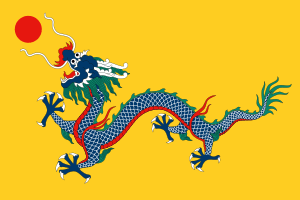Self-Strengthening Movement facts for kids

The Self-Strengthening Movement (also known as Chinese: 洋務運動 or 自強運動) was a big effort to make China stronger. It happened in the Qing Dynasty from 1861 to 1895. This movement aimed to modernize China. Leaders wanted to learn from Western countries. They focused on new technology and military strength.
China had faced tough times before this movement. They lost battles in the Opium Wars. A huge uprising called the Taiping Rebellion also caused problems. These events made the emperor and his officials worried. They feared the Qing government might fall. To stop this, they started the Self-Strengthening Movement. It was sometimes called "Westernization." The main goal was to bring in Western ideas, especially in technology.
The movement had three main periods:
- The first phase was from 1861 to 1872.
- The second phase was from 1872 to 1885.
- The third phase was from 1885 to 1895.
Contents
Who Led the Movement?
Many important people helped lead the Self-Strengthening Movement. They were often high-ranking officials. They believed China needed to change to survive.
Here are some of the key leaders:
- Yixin, Prince Gong (Chinese: 恭親王)
- Wenxiang (Chinese: 文祥)
- Zeng Guofan (Chinese: 曾國藩)
- Li Hongzhang (Chinese: 李鴻章)
- Zuo Zongtang (Chinese: 左宗棠)
- Shen Baozhen (Chinese: 沈葆禎)
- Zhang Zhidong (Chinese: 張之洞)
These leaders worked hard to bring new ideas to China. They focused on building factories and modern armies.
What Did They Do?
The leaders of the Self-Strengthening Movement focused on several key areas. Their main goal was to make China strong again. They wanted to protect China from outside threats.
Building Modern Factories
One major part of the movement was building new factories. These factories used Western technology. They made modern weapons and ships. This was a big change for China.
For example, they built:
- Arsenals: Places to make guns and cannons.
- Shipyards: Places to build modern warships.
These new factories helped China produce its own military equipment. This reduced the need to buy from other countries.
Improving the Military
The movement also focused on making the army and navy better. They bought modern weapons from the West. They also hired foreign experts. These experts trained Chinese soldiers. They taught them new fighting methods.
The goal was to create a strong, modern military. This would help defend China's borders. It would also help put down rebellions inside the country.
Learning from the West
Beyond weapons, the movement encouraged learning. They sent students to study abroad. These students went to countries like Britain and France. They learned about science, engineering, and government.
They also set up schools in China. These schools taught Western subjects. This helped spread new knowledge. It prepared a new generation of leaders.
Developing Infrastructure
Some leaders also saw the need for better infrastructure. This included things like:
- Telegraph lines: For faster communication.
- Mines: To get resources like coal and iron.
These improvements helped support the new factories and military. They also helped China connect better internally.
Why Did It End?
The Self-Strengthening Movement lasted for over 30 years. It brought many changes to China. However, it faced many challenges.
One big reason it ended was the First Sino-Japanese War (1894-1895). China fought against Japan. Despite all the modernization efforts, China lost the war. This showed that the movement had not fully succeeded. It had not made China strong enough.
Many people realized that just copying Western technology was not enough. China needed deeper changes. This included changes to its government and society. The defeat in the war led to new reform efforts.
Images for kids
-
Nanjing Jinling Arsenal (金陵造局), built by Li Hongzhang in 1872.
-
Chinese warship Yangwu, built at the Fuzhou Arsenal in 1872.
-
Gun transportation at Shanghai Jiangnan Arsenal (上海江南製造兵工廠).
See also
 In Spanish: Movimiento de autofortalecimiento para niños
In Spanish: Movimiento de autofortalecimiento para niños
















